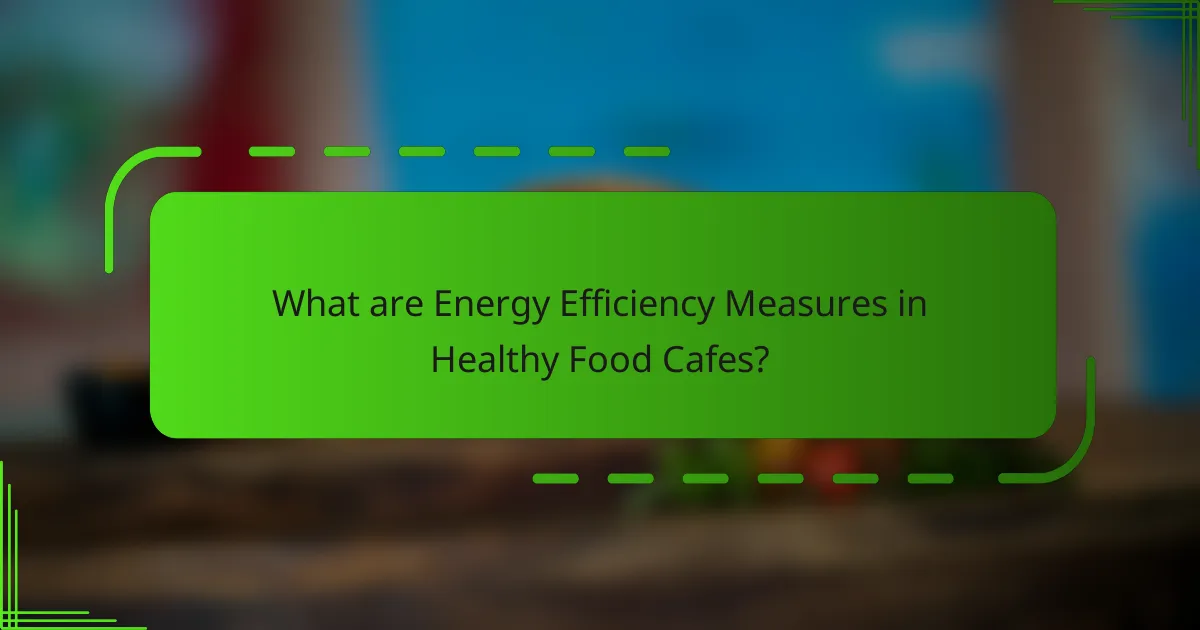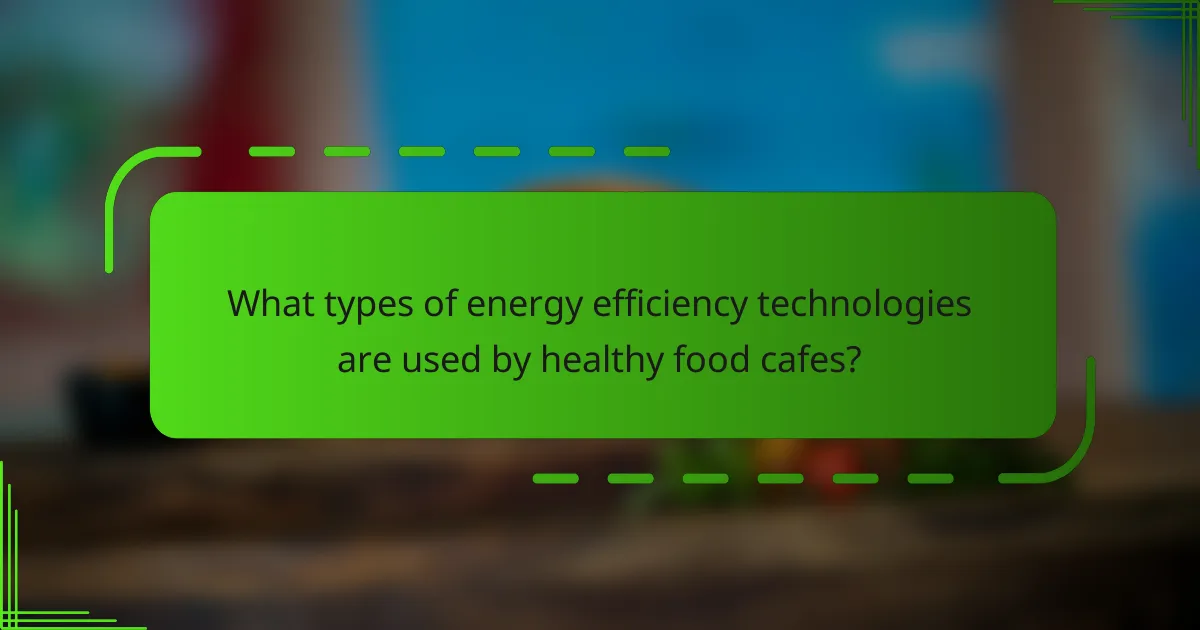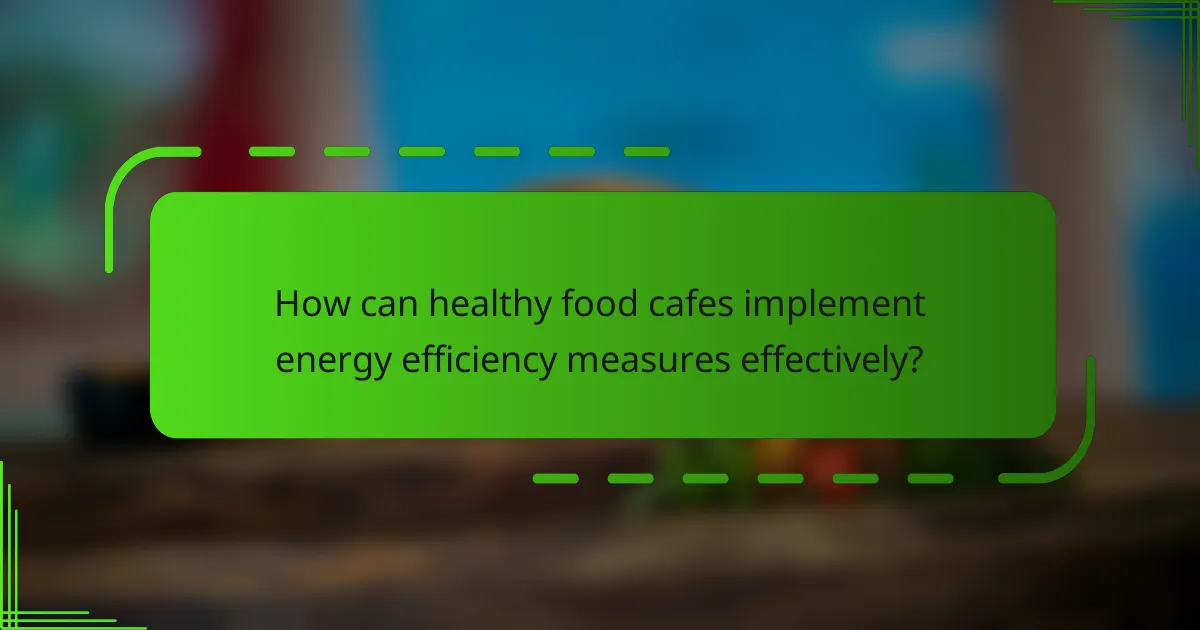Healthy food cafes are increasingly adopting energy efficiency measures to optimize energy use and reduce waste. Key strategies include the installation of energy-efficient appliances, such as LED lighting and Energy Star-rated equipment, as well as the implementation of smart thermostats and energy management systems to monitor consumption. Additional practices like insulation improvements, batch cooking, and regular maintenance further enhance energy savings. Research indicates that these measures can lead to significant reductions in energy consumption and operational costs, promoting sustainability within the cafe industry.

What are Energy Efficiency Measures in Healthy Food Cafes?
Energy efficiency measures in healthy food cafes include optimizing energy use and reducing waste. These measures often involve the installation of energy-efficient appliances, such as LED lighting and Energy Star-rated equipment. Cafes may also implement smart thermostats to regulate heating and cooling efficiently. Additionally, utilizing energy management systems can help track and analyze energy consumption.
Insulation improvements and energy-efficient windows can further reduce heating and cooling costs. Cafes often promote practices like batch cooking to minimize energy use during peak hours. Regular maintenance of equipment ensures optimal performance and energy savings. According to the U.S. Department of Energy, these measures can lead to significant reductions in energy consumption and costs.
How do energy efficiency measures impact the operations of healthy food cafes?
Energy efficiency measures significantly enhance the operations of healthy food cafes. These measures reduce energy consumption, leading to lower operational costs. For instance, energy-efficient appliances can decrease energy use by 20-50%. This reduction translates to savings on utility bills. Additionally, efficient lighting improves ambiance while using less power. Cafes adopting these measures often report increased customer satisfaction. Sustainable practices can also attract eco-conscious consumers. Furthermore, energy efficiency can lead to improved compliance with environmental regulations. This compliance can enhance the cafe’s reputation in the community.
What specific energy efficiency measures are commonly adopted?
Commonly adopted energy efficiency measures include LED lighting, energy-efficient appliances, and smart thermostats. LED lighting reduces energy consumption by up to 75% compared to traditional bulbs. Energy-efficient appliances, such as Energy Star-rated equipment, use less electricity and can significantly lower utility bills. Smart thermostats optimize heating and cooling schedules, leading to energy savings of about 10-15%. Insulation improvements enhance building energy performance by minimizing heat loss. Additionally, utilizing renewable energy sources, like solar panels, can further increase energy efficiency and sustainability. These measures collectively contribute to lower energy costs and reduced environmental impact for healthy food cafes.
How do these measures contribute to sustainability in the food industry?
Energy efficiency measures adopted by healthy food cafes significantly enhance sustainability in the food industry. These measures reduce energy consumption, leading to lower greenhouse gas emissions. For instance, energy-efficient appliances can cut energy use by up to 30%. This reduction in energy demand lessens reliance on fossil fuels. Additionally, implementing sustainable practices often lowers operational costs. Cafes that prioritize energy efficiency can reinvest savings into local sourcing and sustainable ingredients. This creates a positive feedback loop, benefiting both the environment and local economies. Studies show that energy-efficient cafes attract environmentally conscious customers, further promoting sustainable practices in the food sector.
Why are energy efficiency measures important for healthy food cafes?
Energy efficiency measures are important for healthy food cafes because they reduce operational costs and promote sustainability. Implementing energy-efficient appliances can lower energy consumption significantly. For instance, energy-efficient refrigerators use up to 50% less energy than standard models. This reduction in energy use leads to lower utility bills, which can enhance profitability. Additionally, energy efficiency contributes to a smaller carbon footprint. Cafes that prioritize sustainability attract eco-conscious customers. Studies show that 66% of consumers prefer brands that are environmentally responsible. Therefore, adopting energy efficiency measures aligns with both economic and ethical goals for healthy food cafes.
What financial benefits do cafes experience from adopting energy efficiency measures?
Cafes experience significant financial benefits from adopting energy efficiency measures. These benefits include reduced energy costs, which can lower operational expenses. For example, energy-efficient appliances can decrease electricity consumption by up to 30%. This reduction translates to substantial savings over time. Additionally, cafes may qualify for tax incentives and rebates for implementing energy-efficient technologies. These financial incentives can further enhance profitability. Moreover, energy-efficient practices can attract environmentally conscious customers, potentially increasing sales. Research indicates that businesses adopting energy efficiency measures see an average return on investment of 20%. Overall, energy efficiency measures contribute to both cost savings and increased revenue for cafes.
How do energy efficiency measures enhance customer experience?
Energy efficiency measures enhance customer experience by reducing operational costs and improving service quality. Implementing energy-efficient appliances lowers energy bills, allowing cafes to offer competitive pricing. This financial benefit can be passed on to customers through lower menu prices. Additionally, energy-efficient lighting and climate control create a more comfortable and inviting atmosphere. Studies show that comfortable environments increase customer satisfaction and dwell time. For example, a well-lit and temperature-regulated space encourages patrons to stay longer and enjoy their meals. Overall, these measures contribute to a positive dining experience, fostering customer loyalty and repeat visits.

What types of energy efficiency technologies are used by healthy food cafes?
Healthy food cafes utilize various energy efficiency technologies. These include energy-efficient appliances such as refrigerators and ovens. LED lighting is commonly used to reduce electricity consumption. Smart thermostats help optimize heating and cooling systems. Insulation improvements minimize energy loss. Solar panels are often installed to harness renewable energy. Water-saving devices, like low-flow faucets, contribute to overall efficiency. Energy management systems monitor and control energy use effectively. These technologies collectively enhance sustainability and reduce operational costs.
How do lighting solutions improve energy efficiency in cafes?
Lighting solutions improve energy efficiency in cafes by using advanced technologies like LED bulbs. These bulbs consume up to 75% less energy than traditional incandescent lights. They also have a longer lifespan, reducing the frequency of replacements. Smart lighting systems can adjust brightness based on natural light availability. This further optimizes energy use throughout the day. Studies show that energy-efficient lighting can lead to significant cost savings on electricity bills. For instance, cafes that switch to LED lighting can save an average of $100 annually per fixture. Overall, adopting efficient lighting solutions helps cafes reduce their carbon footprint while enhancing the customer experience.
What are the benefits of using LED lighting?
LED lighting offers numerous benefits, particularly in energy efficiency. It uses up to 75% less energy than traditional incandescent bulbs. LED lights have a longer lifespan, lasting up to 25,000 hours compared to 1,000 hours for incandescent bulbs. This longevity reduces replacement frequency and waste. Additionally, LED lighting emits less heat, which can lower cooling costs in cafes. The technology is also more durable, making it less prone to breakage. Furthermore, LED lights provide instant brightness and are available in various colors and designs. These factors contribute to overall cost savings and environmental sustainability for healthy food cafes.
How can natural lighting be integrated into cafe design?
Natural lighting can be integrated into cafe design through strategic window placement and skylights. Large windows allow ample sunlight to enter the space. This reduces reliance on artificial lighting during the day. Skylights can also bring natural light into areas that windows cannot reach. Using light-colored materials for walls and furnishings enhances the reflection of natural light. Open floor plans can facilitate the flow of light throughout the cafe. Additionally, incorporating outdoor seating can extend the experience of natural light to customers. Studies show that natural lighting improves mood and boosts productivity, making it a beneficial design choice for cafes.
What role do energy-efficient appliances play in healthy food cafes?
Energy-efficient appliances play a crucial role in healthy food cafes by reducing energy consumption. These appliances help lower operational costs, allowing cafes to allocate resources to high-quality ingredients. They also minimize environmental impact, aligning with the values of health-conscious consumers. Studies show that energy-efficient appliances can reduce energy use by 10-50%. This reduction contributes to sustainability goals. Additionally, energy-efficient appliances often have improved performance, enhancing food quality and safety. Implementing these appliances can also qualify cafes for energy rebates, further supporting their financial viability.
Which appliances are considered energy-efficient?
Energy-efficient appliances include refrigerators, dishwashers, washing machines, and ovens. These appliances are designed to use less energy while performing their functions effectively. For example, ENERGY STAR certified refrigerators consume about 15% less energy than non-certified models. Dishwashers with the ENERGY STAR label can save an average of 3,870 gallons of water over their lifetime. Washing machines that are energy-efficient can reduce energy usage by up to 50%. Ovens designed for energy efficiency often utilize better insulation and advanced technology to minimize heat loss. These appliances contribute to lower energy bills and reduced environmental impact.
How do energy-efficient appliances reduce operational costs?
Energy-efficient appliances reduce operational costs by consuming less electricity compared to standard appliances. This lower energy consumption directly translates to reduced utility bills. For instance, Energy Star-rated appliances can save households about 30% on energy costs annually. Additionally, these appliances often have longer lifespans, leading to fewer replacement costs over time. The initial investment in energy-efficient models is often offset by the savings accrued through lower energy bills. Furthermore, many energy-efficient appliances operate more effectively, enhancing productivity and reducing maintenance costs. Overall, the cumulative savings from energy efficiency contribute significantly to lower operational expenses for businesses and households alike.

How can healthy food cafes implement energy efficiency measures effectively?
Healthy food cafes can implement energy efficiency measures effectively by adopting energy-efficient appliances. These appliances consume less energy while performing the same tasks as standard models. For instance, Energy Star-rated ovens and refrigerators can reduce energy use by 10-50%.
Additionally, cafes should utilize LED lighting, which uses up to 75% less energy than traditional bulbs. Installing programmable thermostats can optimize heating and cooling, leading to energy savings of 10-30%.
Implementing energy management systems allows cafes to monitor and control energy consumption in real-time. Regular maintenance of equipment ensures optimal performance, further enhancing energy efficiency.
Lastly, staff training on energy-saving practices can promote a culture of efficiency. Research shows that employee engagement can lead to a 5-15% reduction in energy consumption.
What strategies can cafes adopt to promote energy efficiency?
Cafes can adopt several strategies to promote energy efficiency. Implementing energy-efficient appliances is crucial. These appliances consume less power and reduce energy bills. Utilizing LED lighting can significantly lower electricity usage. Studies show that LED lights use 75% less energy than traditional bulbs. Cafes should also consider optimizing heating and cooling systems. Programmable thermostats can help maintain efficient temperature levels. Insulating windows and doors can prevent energy loss. Additionally, using energy management systems can monitor and optimize energy consumption. Educating staff about energy-saving practices can further enhance efficiency. These strategies collectively contribute to a sustainable and cost-effective operation.
How can staff training contribute to energy efficiency?
Staff training can significantly contribute to energy efficiency by equipping employees with knowledge and skills to optimize energy use. Trained staff can identify energy waste and implement best practices in daily operations. For example, training on the proper use of kitchen equipment can reduce energy consumption during food preparation.
Additionally, staff awareness of energy-efficient practices can lead to better maintenance of appliances, extending their lifespan and efficiency. Research indicates that organizations with trained staff can achieve up to 20% energy savings. This is supported by the U.S. Department of Energy, which highlights the importance of employee engagement in energy management programs.
What role does customer education play in energy-saving practices?
Customer education plays a crucial role in energy-saving practices. It empowers consumers with knowledge about efficient energy use. Educated customers are more likely to adopt energy-saving behaviors. For instance, they can learn about the benefits of energy-efficient appliances. Research shows that informed consumers can reduce energy consumption by 10% to 30%. This reduction contributes to lower utility bills and a smaller carbon footprint. Additionally, cafes that educate their customers enhance their brand reputation. This leads to increased customer loyalty and engagement. Overall, effective customer education is essential for promoting energy efficiency in cafes.
What are some common challenges faced by cafes in adopting energy efficiency measures?
Cafes face several challenges in adopting energy efficiency measures. High initial costs deter many cafes from investing in energy-efficient equipment. Limited knowledge about available technologies also hampers implementation. Additionally, the complexity of retrofitting existing systems can be overwhelming. Cafes may struggle with staff training on new practices. Furthermore, the perceived disruption during upgrades can lead to operational hesitance. Lastly, financial incentives and support programs may not be widely known or accessible, limiting adoption efforts.
How can cafes overcome financial barriers to implementing energy efficiency?
Cafes can overcome financial barriers to implementing energy efficiency by exploring various funding options. Grants and incentives from government programs can significantly reduce upfront costs. Many local and state governments offer financial assistance for energy-efficient upgrades. Additionally, cafes can consider energy performance contracts, which allow them to pay for improvements through energy savings.
Investing in energy-efficient equipment often leads to long-term savings on utility bills. For example, Energy Star appliances can reduce energy use by 10-50%. Cafes can also collaborate with utility companies that provide rebates for energy-efficient installations.
Lastly, forming partnerships with other businesses can help share costs and resources for energy efficiency projects. This collaborative approach can lower the financial burden while enhancing overall sustainability efforts.
What are the potential setbacks in transitioning to energy-efficient practices?
Potential setbacks in transitioning to energy-efficient practices include high initial costs. Implementing energy-efficient technologies often requires significant upfront investment. Many cafes may struggle with budget constraints. Additionally, there can be a lack of technical expertise. Staff may need training to effectively utilize new systems. Transitioning can also lead to temporary disruptions in operations. This can affect customer service and satisfaction during the changeover. Furthermore, some energy-efficient solutions may not deliver immediate returns. It can take time to see savings on energy bills. Overall, these challenges can hinder the adoption of energy-efficient practices in healthy food cafes.
What best practices can healthy food cafes follow for energy efficiency?
Healthy food cafes can adopt several best practices for energy efficiency. First, using energy-efficient appliances can significantly reduce energy consumption. For example, Energy Star-rated equipment uses up to 50% less energy than standard models. Second, implementing LED lighting saves energy and has a longer lifespan compared to traditional bulbs. Third, optimizing heating and cooling systems with programmable thermostats can lead to energy savings of 10-30%. Fourth, utilizing natural light through windows or skylights can minimize the need for artificial lighting during the day.
Fifth, cafes can adopt energy management systems to monitor and control energy usage effectively. Sixth, training staff on energy-saving practices can enhance overall efficiency. Lastly, sourcing local produce reduces transportation energy costs and supports sustainability. These practices not only lower energy bills but also contribute to a more sustainable operation.
How can cafes monitor and evaluate their energy usage effectively?
Cafes can monitor and evaluate their energy usage effectively by implementing energy management systems. These systems track energy consumption in real-time, providing data on usage patterns. Smart meters can be installed to measure electricity, gas, and water usage accurately. Regular audits can identify areas of inefficiency and suggest improvements. Staff training on energy conservation practices can further enhance monitoring efforts. Additionally, cafes can utilize energy benchmarking against similar establishments to evaluate performance. According to the U.S. Department of Energy, monitoring energy use can lead to a reduction of 10-30% in energy costs.
What tips can cafes implement for continuous improvement in energy efficiency?
Cafes can implement several tips for continuous improvement in energy efficiency. First, they should conduct regular energy audits to identify areas of waste. This helps in understanding energy consumption patterns. Second, upgrading to energy-efficient appliances can significantly reduce energy usage. Appliances with the ENERGY STAR label consume less energy. Third, optimizing heating, ventilation, and air conditioning (HVAC) systems enhances efficiency. Regular maintenance of these systems ensures they operate effectively. Fourth, utilizing smart thermostats allows for better temperature control based on occupancy. This can lead to reduced energy costs. Fifth, cafes should consider using LED lighting which consumes less energy and lasts longer than traditional bulbs. Lastly, training staff on energy-saving practices fosters a culture of efficiency within the cafe. Implementing these strategies can lead to substantial energy savings and reduced operational costs.
Energy efficiency measures in healthy food cafes focus on optimizing energy use and minimizing waste through various technologies and practices. Key strategies include the installation of energy-efficient appliances, LED lighting, smart thermostats, and energy management systems, all of which contribute to reduced operational costs and enhanced sustainability. The article explores the impact of these measures on cafe operations, customer experience, and compliance with environmental regulations, while also addressing common challenges and best practices for implementation. Additionally, it highlights the financial benefits of adopting energy-efficient technologies and the importance of staff and customer education in promoting energy-saving practices.